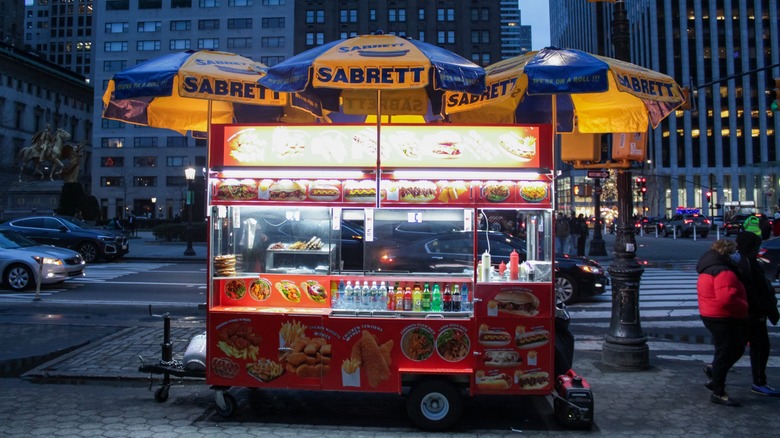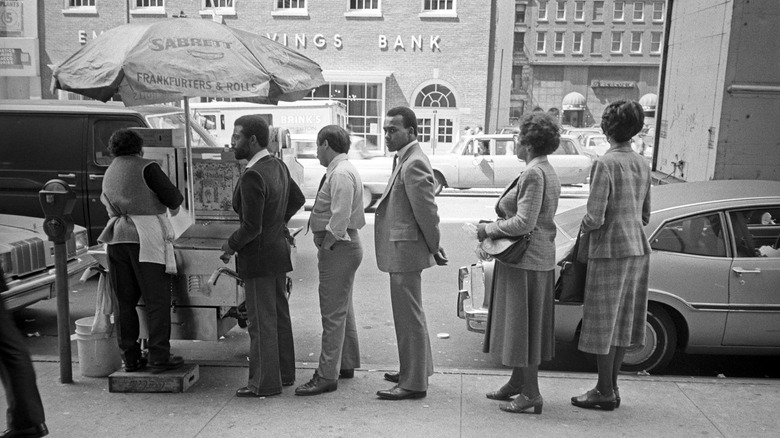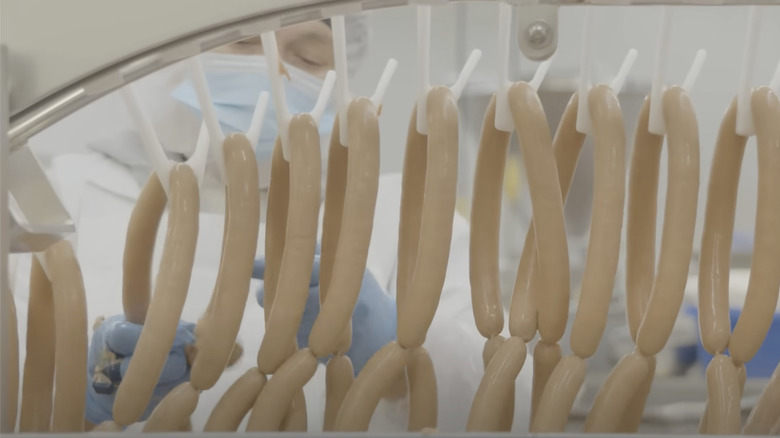The Iconic Brand Behind New York-Style Hot Dogs
The United States boasts many regional hot dog styles, and while each has its fervent fandoms, there are two cities that stand above the rest as the unquestionable hot dog capitals of the country. You have Chicago-style hot dogs, which are bound to a strict set of rules, particularly regarding acceptable toppings. Then you have New York, the origin point of America's hot dog obsession, where German immigrants first introduced frankfurters to the States. To this day, New York-style hot dogs remain a quintessential mark of the city, their iconic status only rivaled by the famous thin-crust pizza.
According to the Huffington Post, there are an estimated 5,000 food carts in the Big Apple, and a majority of them sell New York-style hot dogs. Not only that, but a good portion of these carts sell the exact same brand: Sabrett. Their carts are instantly recognizable by their umbrellas, bearing blue and yellow stripes, a visual icon of New York on par with yellow taxis and Yankee hats. In addition to the carts, Sabrett has also supplied landmark restaurants like Katz's Delicatessen and Papaya King, according to Eater. They even supplied Nathan's hot dogs for a period, holding a virtual monopoly on the city's sausage scene. How one brand achieved such dominance is a story that goes back nearly a century.
The history of Sabrett hot dogs
Sabrett's history is a tale of two companies. The first was founded in 1926 by Samuel Ogus and Fritz Frankel, European immigrants who arrived in the United States via Ellis Island. They originally named it the Sabre Meat Company, but they soon discovered that another company already owned the Sabre name. Since it was a very small company at the time, it was rebranded as Sabre-ette, implying a small sabre, which was later shortened to Sabrett. In addition to making hot dogs, the company sold hamburgers and homemade buns. The business grew steadily, taking a major leap when Nathan's contracted them as a supplier, but it truly reached iconic status when its hot dog carts hit the streets.
The second tale begins with Gregory Papalexis. Raised in Manhattan, hot dogs were a steady presence since childhood; his father owned a bakery and their neighbor was a hot dog factory. After graduating college in 1948, he took his first step into the food business by purchasing his father's bakery with a $2,500 G.I. loan. Hot dog buns were a specialty, with Papalexis supplying numerous New York eateries, but he ultimately recognized that there was more success to be found if he made the sausages as well. His business, House O' Weenies, was a massive success, and in 1964, he established Marathon Enterprises and purchased competitor: Sabrett. House O' Weenies actually outsold Sabrett, but they chose the Sabrett name because the blue and yellow umbrellas had become so iconic.
Inside the Sabrett factory
According to a video by New York Times Cooking, Sabrett ranks as America's sixth-largest hot dog distributor today. Overseen by Papalexis's sons-in-law, its New Jersey factory pumps out a whopping 800,000 to 1.2 million hot dogs per day. The hot dog-making process begins in the chopper room, where beef gets ground by chopping machines and emulsification systems. They use bone-in beef, which means that every Sabrett hot dog does contain pulverized bone. It is, admittedly, not the most appetizing of thoughts, but the emulsification machines are so powerful that the bones are completely annihilated into powder. Leaving the smooth, uniform paste that ultimately becomes your dog. Every batch of meat goes through an X-ray machine, and if any solid fragments of bone are found, the entire batch is deemed unfit for sale and thrown away.
Once the meat has been ground to a paste, it gets stuffed into hotdog casings and baked within plastic molds that assure a straight, uniform shape. At this point, the hot dogs are hanging in long chains of links, and when they finish baking, the plastic molds come off, and the individual links are separated. If you took all the hot dogs Sabrett produces per year and lined them up end-to-end, it would reach from New York to Los Angeles and back 10 times.
There's one Sabrett product whose manufacturing process is wholly unknown to laypeople: their secret onion sauce. Invented by Papalexis's friend Alan Geisler, its recipe is closely guarded, lending an air of mystery to an already iconic brand.


